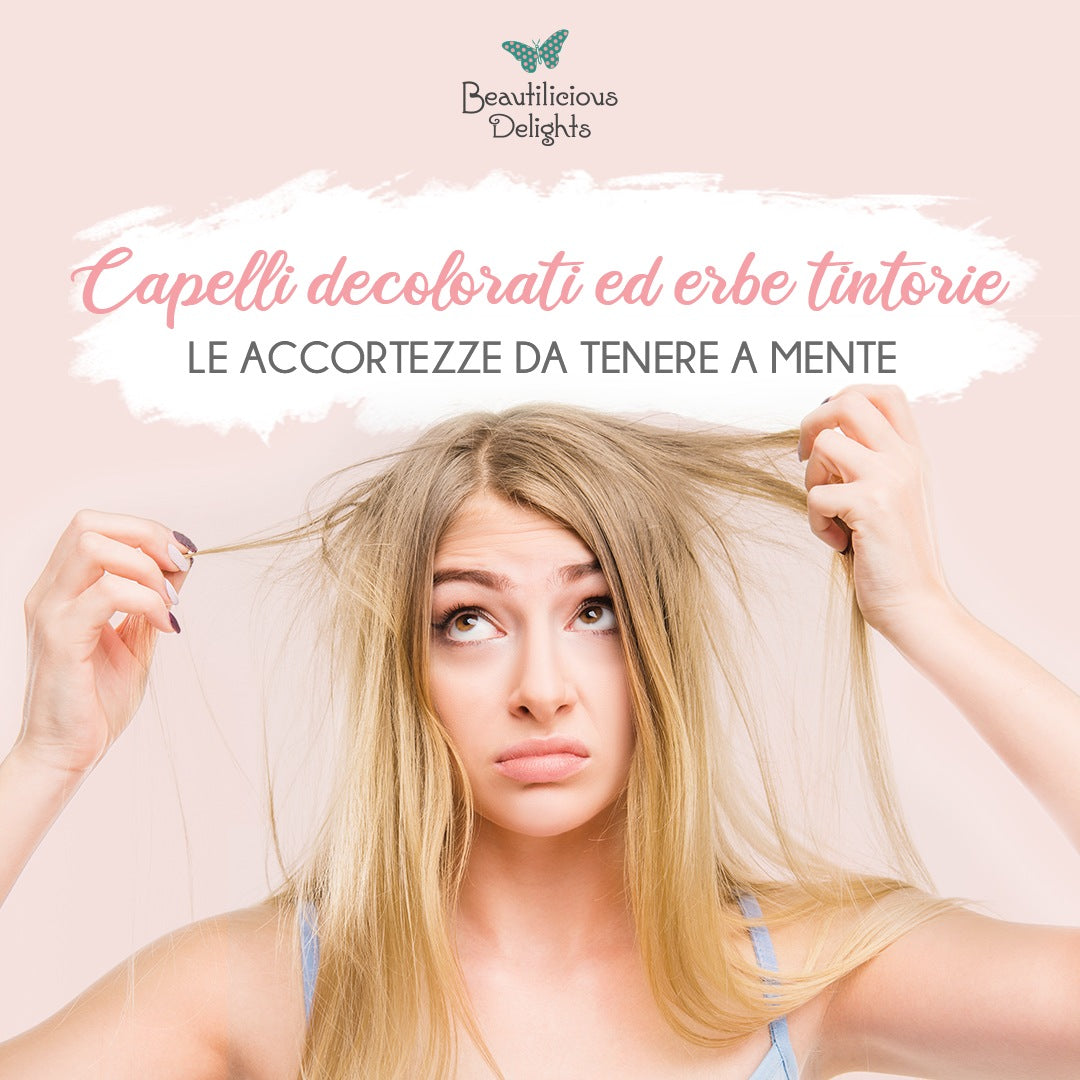Raise your hand who, tired of the usual color, hasn't been touched by the thought of resorting to discoloration to distort the color of a life? And I bet that those who don't dare to bleach all their hair resort to the famous highlights , thus hoping to contain the damage a little. I confess I did too.
What happens when we bleach our hair?
Hair is made up of up to 95% keratin which is a sulfur-rich protein.
The hair is as we see it thanks to the union of the filaments of cysteine (amino acid) through the sulphide bridges.
I know, it sounds complex but I'm going into these specifics to be able to explain more easily what happens when we decide to bleach our hair.
Well, when a discoloration is carried out, melanin (the pigment that gives color to our hair) is oxidized which indirectly means that the percentage of keratin present inside the hair decreases and the disulphide bridges and cysteine filaments break .
Unfortunately, cystine bridges are destroyed in some cases up to 50% and therefore also the strength of the shaft is reduced by about half.
The discoloration is an aggressive chemical treatment not only for the stem which becomes brittle and dry but also for the skin. Hair becomes more porous and consequently more sensitive to humidity, atmospheric agents but also to all other chemical or mechanical treatments.
The scales of the hair are lifted so that the bleaching product penetrates deeply, subtracting melanin and lightening the shaft of its original colour.
The discoloration operation will therefore necessarily lead to damage to both the cuticle and the cortex with structural weakening of the hair.
Therefore persevering and repeating the discoloration several times produces permanent damage to the cuticle which remains permanently open causing a continuous loss of hydration with the consequence that the hair will appear dull and dull.
Repeating the discoloration on an already tried hair means finding yourself with an increasingly weak, fragile and prone to break easily stem.
Having bleached, dehydrated and dull hair is a problem you always want to fix because nobody likes having the infamous straw effect on their heads.
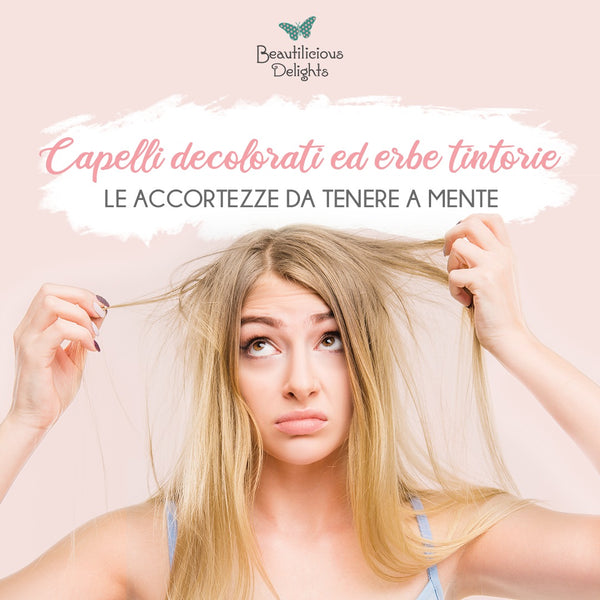
The important thing is YES, run for cover BUT consciously without persevering in the mistakes that damage your hair.
From how I'm talking about it, this process of ''rehabilitation'' of the hair may seem simple, but it is also complicated using totally natural products such as dyeing or healing herbs.
The risk of having green reflections due to discoloration is around the corner and dekeratinized lengths are a grain not to be underestimated.
Even lawsonia inermis (red henna) - and in general the vegetable pigment - struggles to take uniformly and discharges much more and much more easily. But fear not: as long as there is awareness, there is hope.
What Ayurvedic healing herbs to use on bleached hair?
What are the healing herbs that DO NOT change the light shade of the hair?
One of the main needs of hair abused with chemical treatments is to try to strengthen them and to combat the strong dryness characteristic of these hard-tested hair.
Healing herbs that do not alter light shades (natural or bleached) are
Don't forget, remember to moisturize Methi before use as indicated in my tutorial to avoid further drying your hair. The mucilage it releases is a godsend for a stem that constantly loses hydration due to the perpetually open cuticles.
Amla, rhubarb, walnut hull , even if they are only reflective herbs, are to be avoided because they would change your starting color.
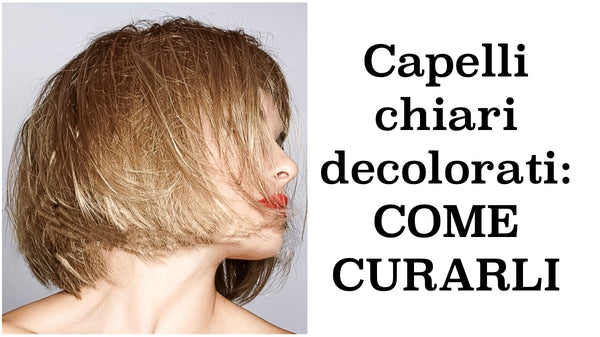
Can I use Cassia (neutral henna) on my bleached hair?
Cassia (neutral henna) should ALWAYS be used after a test on a hidden lock because they could leave greenish reflections on some hair. It rarely happens and it's very subjective also based on how strong and aggressive the discoloration was.
I know, it's not very heartening not to have a variety of choices but it's better than nothing.
For dehydrated lengths I recommend the Hair Elixir spray which you will no longer be able to do without.
You can use it
- both on damp hair, before styling to condition it and remove the feeling of dryness without weighing it down
- and as styling on dry hair in the days following shampooing. Cuddle that becomes essential especially if you go to the beach.
You can learn more about this topic here too: Hair, sun, sea: discover the protective hair spray
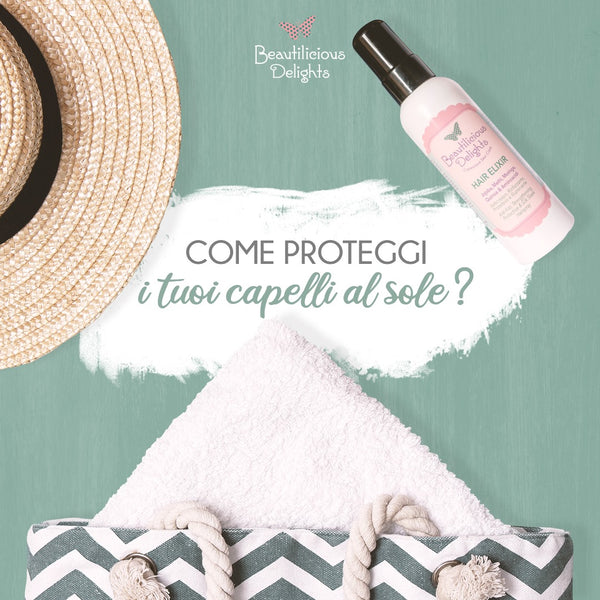
It is very important to balance the humidity level of the stem, especially at the beach or in the pool, to have softer and more manageable hair.
The Hair Elixir Spray can be the ideal ally in these cases, because not only is it essential in terms of protection, but it can help you prevent dryness with dedicated wraps, as well as in the styling phase.
It is a spray with a light consistency, which leaves your hair shiny, silky and enveloped in a floral scent capable of giving a feeling of freshness and lightness.
Can I wash my bleached hair with cleansing herbs?
Again, better safe than sorry.
Both Sidr, Aritha Glow or Shikakai should only be used after carrying out a test on a hidden lock. THE
The permanence time of the washing batter on the hair is minimal but since each stem is a world unto itself and whether or not you find strange reflections can also vary according to the type of discoloration undergone ( light, medium or strong ) it is always better to be cautious .
Can I use henna and herbal dyes on my bleached hair?
Yes, as long as you do it with awareness. Having reached the end of this article, I am sure you will be able to use herbal dyes without running the risk of finding yourself with green hair.
Before proceeding to color with dyeing herbs a hair that has lightened or is completely discolored, it is necessary to re-pigment the stem which is emptied and dekeratinized.
What does it mean to "repigment" the stem?
Repigmentation rebuilds the cosmetic pigment in hair that has lost it due to natural or artificial causes.
Repigmentation should always be done with warm tones (gold, copper or red) and the intensity should always be related to the intensity of the desired final color and the residual tone existing on the hair.
It is therefore necessary to add back the lost warm pigments, before further coloring the hair. All this is necessary to promote uniform absorption of the plant pigment.
In the case of dyeing herbs, the repigmentation must be done with the help of pure lawsonia inermis (red henna) .
Why? Because it's the only one that can combat greenish reflections if a dye mix is applied to bleached hair without first re-pigmenting the stem.
PLEASE NOTE:
Make sure that the lawsonia you are going to use is not picramate added to remedy green-tinged hair (in the best case) or to find yourself with "burnt" hair (in the worst case) following the chemical reaction that could occur between the sodium picramate and the bleaching powder used in the bleaching phase.
Based on how light the hair is following the discoloration suffered and the final shade you want to obtain, repigmentation can be done with pure lawsonia or diluted with cassia.
A single application of lawsonia may be enough to repigment the stem if the lightening is light, as well as 3-4 applications could be needed if the discoloration performed was strong and invasive.
Based on how aggressive the discoloration on the stem was, you will notice that the vegetable pigment struggles to take uniformly and that it also discharges much more than your natural regrowth.
In addition to layering application after application, the lawsonia pigment creates a natural film around the stem which, in addition to coloring, also becomes protective.
Can I use ready mixes of herbal dyes on my bleached hair?
I advise you to do this only after re-pigmenting with the lawsonia.
"But I don't want to go auburn, I want to use a blond henna"
Consider that madder, rhubarb, hibiscus will never give strange reflections but if your "blonde" mix of dyeing herbs contains indigo or katam which release a blue vegetable pigment, obtaining a greenish hue becomes a certainty.
This is basic colorimetry: if you add the blue pigment of katam or indigo to yellow (your bleached hair), you will get green.
It goes without saying that the same is also true for naturally light or white hair. If you apply pure indigo or katam to naturally blonde hair or white regrowth, you'll get a greenish hue. To overcome this, lawsonia is always needed as a first step or in a single mix, together with katam and indigo.
Once the stem has been re-pigmented, you can then proceed with the desired dye mix to obtain the desired shade.
PLEASE NOTE:
the chemically lightened stem is much more porous than the healthy stem therefore venture to use the dyeing herbs on the whole hair ONLY after having done the test on a strand of hair.
Ugh, my bleached hair has green highlights!
Unfortunately some of you contact me with the damage done, with the terror of having to shave your hair. Luckily lawsonia with its red pigment can take cover and remove greenish reflections even if it means becoming brown .
It is always a matter of basic colorimetry: if you add red to green, the result is brown.
I'd say it's an acceptable compromise when faced with the alternative of living with greenish hair or a shaved head. What do you say?
Will my bleached shaft return to being as healthy as before?
Given that once the hair is damaged, it will never be as beautiful as before and that even dyeing herbs cannot perform miracles, however fantastic they are for brittle hair, I can however assure you that you will notice application after application how the shaft changes dramatically. its appearance is incredible both visually and to the touch.
I leave you below 2 testimonials that I'm sure will come in handy and inspire you and will give you confidence that all is not lost for that crazy moment in which you had the unfortunate idea of bleaching your hair.
Find the testimony left by Elena at this link or by clicking on the photo
While at this link you can find Veronica's testimony:
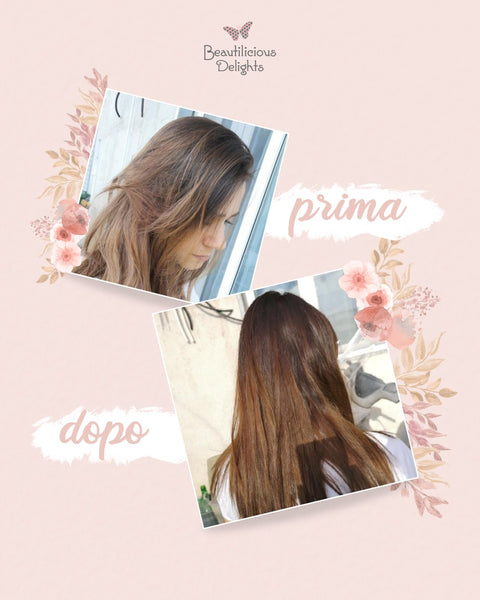
Good luck!
© Beautiful Delights
In the online shop you will find everything you need (including herbal dyes) to take care of your skin and hair in a conscious way. Click HERE to visit it!
************************************************** ************************************
Keep in touch with us:
Follow us on SOCIAL by clicking on the icons below to stay up to date on the latest news:
Rozalia & the Beautilicious Delights Team.

